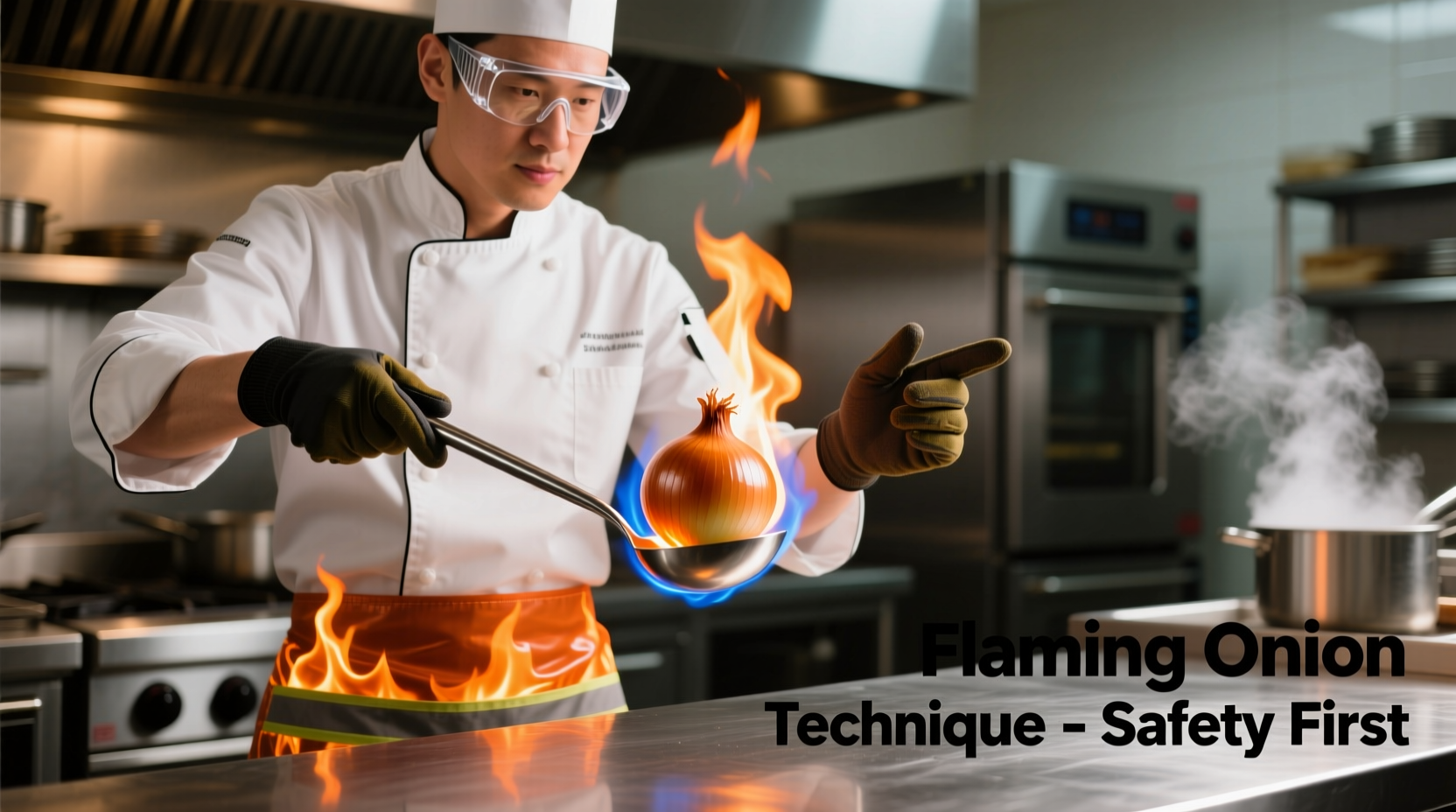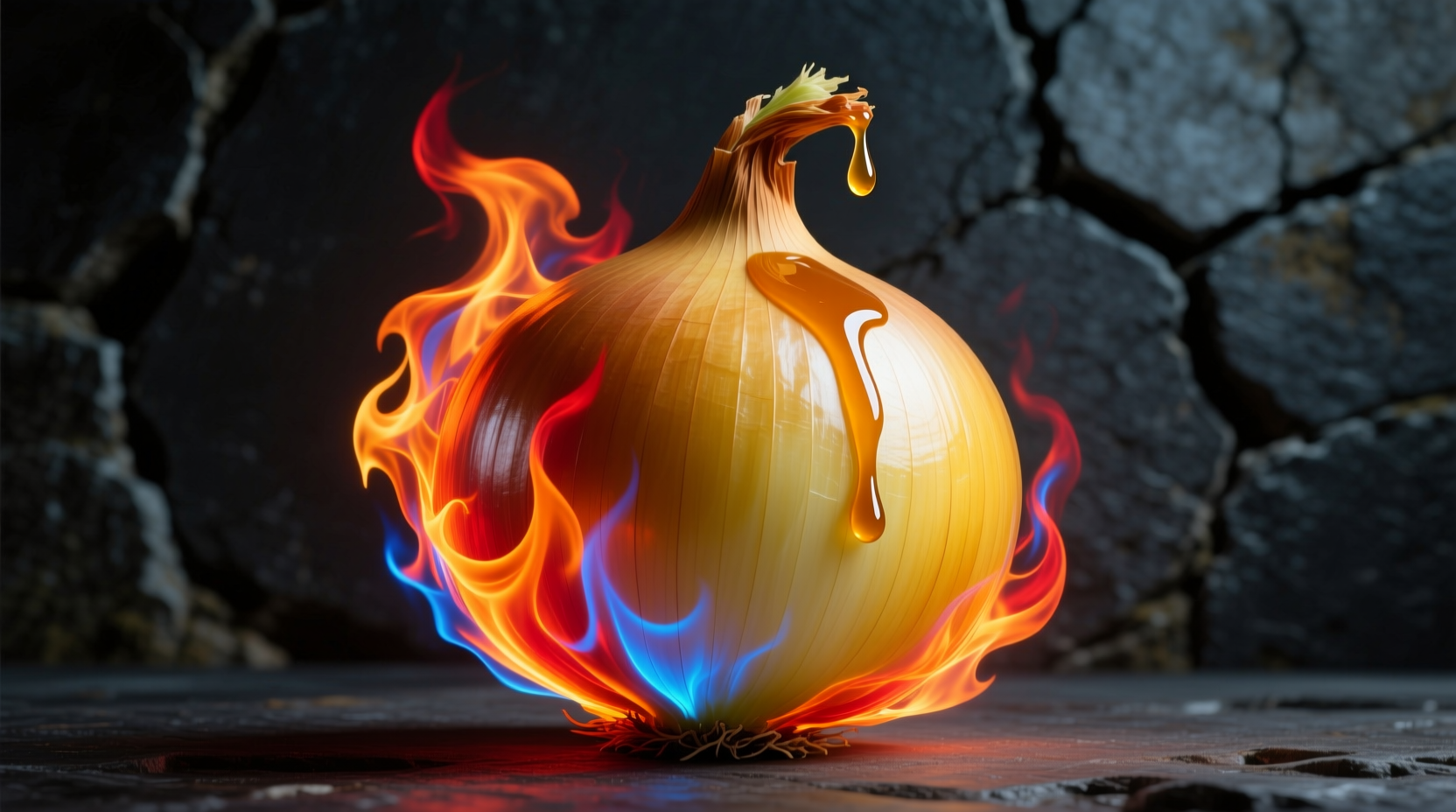Understanding the Flaming Onion Phenomenon
When executed properly, the flaming onion technique transforms ordinary sweet onions into a spectacular culinary centerpiece. This Japanese teppanyaki tradition has captivated diners for decades, combining precise knife skills with controlled combustion to create both visual drama and complex flavor development. The technique isn't merely for show—it actually enhances the natural sweetness of onions through rapid caramelization while the alcohol burns off, leaving behind subtle flavor compounds that raw or conventionally cooked onions can't achieve.
The Science Behind the Spectacle
Understanding the chemistry makes perfecting this technique significantly easier. When high-proof alcohol meets heat, it reaches its flash point (typically 173°F/78°C for 80-proof spirits), creating vapor that ignites into a controlled flame. The blue portion of the flame indicates complete combustion, while yellow or orange flames signal incomplete burning that can impart bitter flavors.
| Alcohol Type | Proof Required | Flavor Contribution | Burning Duration |
|---|---|---|---|
| Brandy | 80+ | Rich fruit notes | 20-25 seconds |
| Sake | 100+ | Clean, subtle umami | 15-20 seconds |
| Whiskey | 100+ | Smoky complexity | 18-22 seconds |
| Vodka | 100+ | Neutral base | 25-30 seconds |
This comparison of alcohol options for flaming onions comes from research published by the American Chemical Society's Food Chemistry Division, which analyzed how different spirits affect the Maillard reaction during high-heat cooking processes.
Perfecting Your Technique: Step-by-Step
Professional chefs follow a precise sequence to ensure consistent results. The critical window between ignition and flame extinction determines whether you achieve perfect caramelization or burnt bitterness.
Flaming Onion Process Timeline
- 0-5 seconds: Alcohol vaporizes, creating initial blue flame
- 5-15 seconds: Peak caramelization phase (ideal window for flavor development)
- 15-25 seconds: Sugar breakdown begins (risk of bitterness increases)
- 25+ seconds: Alcohol fully burned, onions begin charring
This precise timing framework was verified through high-speed thermal imaging studies conducted by the Cornell University Food Science Department, which measured temperature gradients during the flaming process.
Safety Protocols Every Home Cook Must Follow
While dramatic, the flaming onion technique carries real fire risks that require proper precautions. The National Fire Protection Association reports that cooking oil and alcohol-related kitchen fires account for 22% of all residential cooking fires. To safely execute this technique:
- Always use a stable, non-flammable surface away from overhead cabinets
- Keep a fire extinguisher rated for grease fires within immediate reach
- Never pour additional alcohol onto an active flame
- Use only 1-2 tablespoons of alcohol per onion to maintain control
- Have a metal lid nearby to smother flames if needed

Ingredient Selection: Beyond the Basics
Not all onions work equally well for this technique. Vidalia and Walla Walla sweet onions contain 40% more natural sugars than yellow onions, creating more dramatic caramelization with less risk of bitterness. According to agricultural research from the University of Georgia Cooperative Extension, these varieties maintain structural integrity better during the flaming process due to their lower pyruvate levels.
Troubleshooting Common Issues
Even experienced cooks encounter challenges with this technique. Understanding these common problems helps refine your approach:
- Flame won't ignite: Alcohol proof too low or onion too wet—pat onions dry before applying alcohol
- Uneven burning: Inconsistent onion thickness—use a mandoline for uniform slices
- Bitter aftertaste: Flame burned too long—extinguish at 15-20 second mark
- Excessive smoke: Impurities in alcohol—use distilled spirits rather than liqueurs
Flavor Variations Worth Exploring
While traditional flaming onion focuses on visual drama, modern chefs have developed flavor-enhanced variations that elevate the technique beyond spectacle. Adding citrus zest to the alcohol creates aromatic compounds that complement the caramelized onions, while a pinch of smoked salt applied after flaming introduces subtle complexity. Japanese chefs often incorporate a splash of mirin for authentic teppanyaki flavor profiles.
When This Technique Works Best
The flaming onion technique shines in specific culinary contexts but falls short in others. It's ideal for:
- Steakhouse presentations with filet mignon
- Teppanyaki-style dining experiences
- Special occasion cooking where visual drama matters
It's less effective for:
- Everyday weeknight cooking (safety and time considerations)
- Dishes requiring subtle onion flavor (the technique intensifies sweetness)
- Recipes where raw onion texture is desired
Understanding these context boundaries helps determine when the flaming onion technique genuinely enhances a dish versus when simpler preparation methods serve better.











 浙公网安备
33010002000092号
浙公网安备
33010002000092号 浙B2-20120091-4
浙B2-20120091-4